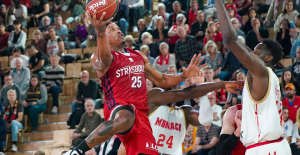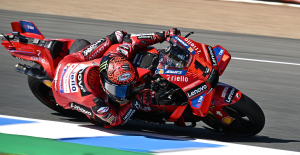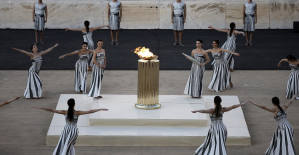It's not a big change for the Croatians. The euro has been a kind of parallel currency in your country for years, and many already calculate in the European currency. However, on January 1st, Croatia will join the euro zone and the euro will replace the kuna in all areas.
The expansion of the euro zone will also be noticed by the other Europeans, in their everyday life at the tills. Because in the new year, new euro coins will come into circulation, which will feature specific Croatian design elements on the reverse.
At first glance, these appear puzzling, but they provide insight into some largely unknown details of European history - and they caused a dispute with the Serbian neighbor in advance.
The two-euro coin is relatively unspectacular: it shows the geographical outline of Croatia. On the other hand, the picture on the Croatian one-euro piece is probably puzzling for most people: it shows a marten.
The reason for this, however, is not a particularly strong bond with nature, rather the name of the previous Croatian currency kuna means "marten" - and this has reasons going back far into history. Animal skins were used as currency in Eastern Europe up until the twelfth century. Furs from squirrels, ermines, but also from martens were used.
Later, silver became a common medium of exchange, and its weight was measured in hryvnia - from which Ukraine derived the name of its currency. If you wanted to pay for smaller things, something was cut from the silver – it was called rubit’ in the Slavic languages, and this became the Russian ruble.
The Croats, on the other hand, remained true to the marten and coined it on a silver coin called Banovac as early as the 13th century. During the Ustasha regime between 1941 and 1945, the country's own currency was named after the marten for the first time, and the kuna was reintroduced in 1994 after independence in 1991 and the subsequent decline of the Croatian dinar. It lives on indirectly in the marten motif on the one-euro coin.
The motif on the copper coins of five, two and one cent goes even further back in history. Because the letters H and R can be seen on it, intertwined – but in Glagolithic script.
This was developed in the 9th century by the Greek monk Konstantin von Saloniki, later called Cyrill, for the missionary work of the Slavs. It was later superseded by a script called Cyrillic, which is still used today for languages spoken by Christian Orthodox speakers.
The peoples with a Catholic majority, on the other hand, went over to Latin letters - only among the Croats did Glagolithic survive for a long time, at least in niches such as for liturgical texts. In the 19th century, the script became a national symbol, with which the Croats distinguished themselves from both the West and the orthodox Serbs.
Finally, the relationship with the Serbs also affects the fourth motif of the Croatian coin design, which can be seen on the euro pieces of 50, 20 and 10 cents. Because the inventor Nikola Tesla is shown on it - and that had already triggered violent protests on the Serbian side when the announcement was made.
Because Tesla was born in 1856 in the village of Smiljan, which today belongs to Croatia. However, his parents were Serbs, his father even an orthodox priest. Therefore, the Serbs consider it one of their own and they have featured it on the Serbian 100 dinar note for many years.
In an online vote in Croatia on the motifs on the euro coins, however, Tesla received by far the most votes with almost 23 percent. Ties, whose Croatian origin is undisputed, as the name already shows, followed in second place with nine percent. No Serb would have objected to a tie motif.
At Tesla, however, some Serbs spoke of "cultural appropriation". Croatia's Prime Minister Andrej Plenković countered at the time that they should be happy that a Serb could be seen on the Croatian euro coins, which ultimately testifies to Croatia's openness.
In addition, Tesla lived most of the time in the USA, became an American citizen and his hometown was part of the Habsburg Empire at the time of his birth - ultimately he was a citizen of the world, someone who had little to do with nationalisms. And in this respect it is a well-chosen motif for a euro coin.
"Everything on shares" is the daily stock exchange shot from the WELT business editorial team. Every morning from 7 a.m. with the financial journalists from WELT. For stock market experts and beginners. Subscribe to the podcast on Spotify, Apple Podcast, Amazon Music and Deezer. Or directly via RSS feed.

 War in Ukraine: when kyiv attacks Russia with inflatable balloons loaded with explosives
War in Ukraine: when kyiv attacks Russia with inflatable balloons loaded with explosives United States: divided on the question of presidential immunity, the Supreme Court offers respite to Trump
United States: divided on the question of presidential immunity, the Supreme Court offers respite to Trump Maurizio Molinari: “the Scurati affair, a European injury”
Maurizio Molinari: “the Scurati affair, a European injury” Hamas-Israel war: US begins construction of pier in Gaza
Hamas-Israel war: US begins construction of pier in Gaza First three cases of “native” cholera confirmed in Mayotte
First three cases of “native” cholera confirmed in Mayotte Meningitis: compulsory vaccination for babies will be extended in 2025
Meningitis: compulsory vaccination for babies will be extended in 2025 Spain is the country in the European Union with the most overqualified workers for their jobs
Spain is the country in the European Union with the most overqualified workers for their jobs Parvovirus alert, the “fifth disease” of children which has already caused the death of five babies in 2024
Parvovirus alert, the “fifth disease” of children which has already caused the death of five babies in 2024 Inflation rebounds in March in the United States, a few days before the Fed meeting
Inflation rebounds in March in the United States, a few days before the Fed meeting Video games: Blizzard cancels Blizzcon 2024, its annual high mass
Video games: Blizzard cancels Blizzcon 2024, its annual high mass Falling wings of the Moulin Rouge: who will pay for the repairs?
Falling wings of the Moulin Rouge: who will pay for the repairs? “You don’t sell a company like that”: Roland Lescure “annoyed” by the prospect of a sale of Biogaran
“You don’t sell a company like that”: Roland Lescure “annoyed” by the prospect of a sale of Biogaran Exhibition: in Deauville, Zao Wou-Ki, beauty in all things
Exhibition: in Deauville, Zao Wou-Ki, beauty in all things Dak’art, the most important biennial of African art, postponed due to lack of funding
Dak’art, the most important biennial of African art, postponed due to lack of funding In Deadpool and Wolverine, Ryan and Hugh Jackman explore the depths of the Marvel multiverse
In Deadpool and Wolverine, Ryan and Hugh Jackman explore the depths of the Marvel multiverse Tom Cruise returns to Paris for the filming of Mission Impossible 8
Tom Cruise returns to Paris for the filming of Mission Impossible 8 Skoda Kodiaq 2024: a 'beast' plug-in hybrid SUV
Skoda Kodiaq 2024: a 'beast' plug-in hybrid SUV Tesla launches a new Model Y with 600 km of autonomy at a "more accessible price"
Tesla launches a new Model Y with 600 km of autonomy at a "more accessible price" The 10 best-selling cars in March 2024 in Spain: sales fall due to Easter
The 10 best-selling cars in March 2024 in Spain: sales fall due to Easter A private jet company buys more than 100 flying cars
A private jet company buys more than 100 flying cars This is how housing prices have changed in Spain in the last decade
This is how housing prices have changed in Spain in the last decade The home mortgage firm drops 10% in January and interest soars to 3.46%
The home mortgage firm drops 10% in January and interest soars to 3.46% The jewel of the Rocío de Nagüeles urbanization: a dream villa in Marbella
The jewel of the Rocío de Nagüeles urbanization: a dream villa in Marbella Rental prices grow by 7.3% in February: where does it go up and where does it go down?
Rental prices grow by 7.3% in February: where does it go up and where does it go down? Even on a mission for NATO, the Charles-de-Gaulle remains under French control, Lecornu responds to Mélenchon
Even on a mission for NATO, the Charles-de-Gaulle remains under French control, Lecornu responds to Mélenchon “Deadly Europe”, “economic decline”, immigration… What to remember from Emmanuel Macron’s speech at the Sorbonne
“Deadly Europe”, “economic decline”, immigration… What to remember from Emmanuel Macron’s speech at the Sorbonne Sale of Biogaran: The Republicans write to Emmanuel Macron
Sale of Biogaran: The Republicans write to Emmanuel Macron Europeans: “All those who claim that we don’t need Europe are liars”, criticizes Bayrou
Europeans: “All those who claim that we don’t need Europe are liars”, criticizes Bayrou These French cities that will boycott the World Cup in Qatar
These French cities that will boycott the World Cup in Qatar Basketball: Strasbourg appeals the victory recovered by Monaco
Basketball: Strasbourg appeals the victory recovered by Monaco Top 14: UBB with Tatafu and Moefana against Bayonne
Top 14: UBB with Tatafu and Moefana against Bayonne MotoGP: Bagnaia dominates qualifying practice in Spain and sets track record
MotoGP: Bagnaia dominates qualifying practice in Spain and sets track record Olympic Games: in Athens, Greece transmits the Olympic flame to France
Olympic Games: in Athens, Greece transmits the Olympic flame to France


















